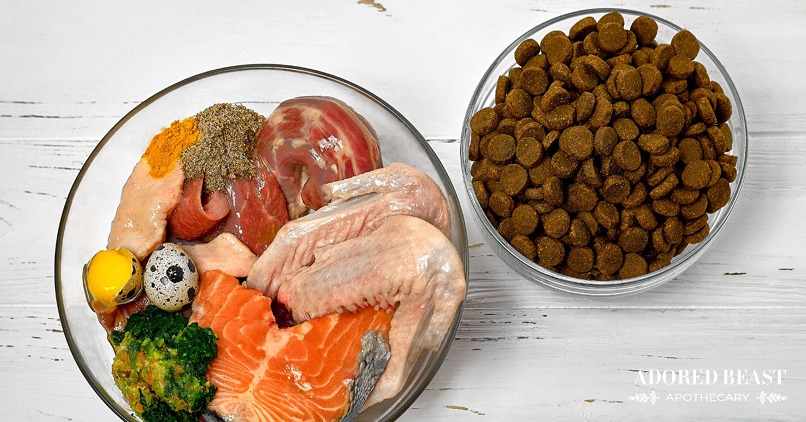Adding fresh food to kibble is a great way to improve the diet. This is a difficult time for some of us and you may have found yourself needing to go back to feeding kibble, or maybe you have been wanting to add some fresh food to kibble but weren’t sure how.
This is an easy, low-stress, recipe for a dog food “topper.” What makes it so easy is that you can skip any step after the first one! Meat is the first ingredient because that is one of the best things we can add to a higher-carb food.
As long as your dog is eating at least the minimum recommended amount of commercial food, it’s generally safe to replace up to 10-20% of kibble with fresh food based on calories and depending on what you are using as the topper. The more you replace, the more important having a nutritionally balanced topper becomes.
Easy Recipe to Add Fresh Food to Kibble

So here’s the recipe.
Start with step 1 and build a better topper with each additional optional step! There’s no need to stress about getting it “perfect,” because this is meant to enhance a processed diet, not to be a complete and balanced diet itself.
Mix ingredients well and form into 20 equally sized meatballs and store in the fridge or freezer. Each meatball is approx. 50 calories. (Feeding suggestions in table below.)
- 1 lb, approx. 450 g, raw ground beef, 90% lean (792 calories). For protein, fat, and energy.
- 50 IU vitamin E (d-alpha tocopherol, not dL-alpha tocopherol the synthetic form). For its antioxidant properties, often lacking in kibble.
- 1 can of sardines, drained, approx. 90 g (167 calories). For omega 3 fatty acids and trace minerals.
- Repeat step 2 for a total of 100 IU vitamin E. As an antioxidant for the omega 3s in sardines.
- 100 g of finely grated carrot, approx. 3/4 cup (41 calories). For fiber and phytonutrients.
- 1/2 tsp, approx. 2.5 g, eggshell powder (calories n/a). For an improved calcium to phosphorus ratio.
- 1 tsp, approx. 2 g, nutritional yeast (8 calories). For B-vitamins.
- 1 large egg, approx. 50 g (72 calories). Overall protein and vitamin/mineral boost. Can be a topper by itself!
(Remember you can stop at, or skip, any step as long as you have step 1.)
Here’s a general feeding guideline by weight
- 10-19lbs – 1 meatball
- 20-29lbs – 1-2 meatballs
- 30-39lbs – 1-3 meatballs
- 40-59lbs – 2-4 meatballs
- 60-79lbs – 2-5 meatballs
- 80-99lbs – 3-6 meatballs
- 100-149lbs – 4-7 meatballs
- 150+lbs – 5-9 meatballs
*If you’re using the full recipe, these are general feeding suggestions based on removing and replacing 10-20% of an average dog’s calories. Your individual dog’s needs may vary. This is intended for occasional and supplemental feeding.












